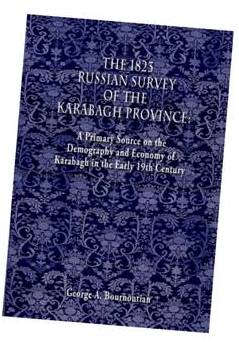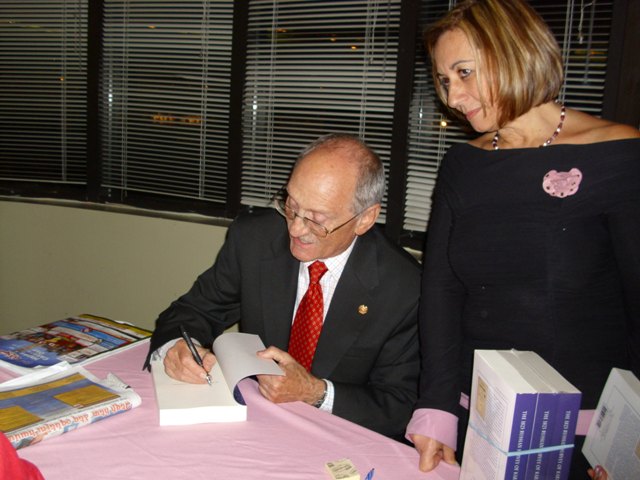
 Book title: “The 1823 Russian Survey of the Karabagh Province: A Primary Source on the Demography and Economy of Karabagh in the Early 19th Century.”
Book title: “The 1823 Russian Survey of the Karabagh Province: A Primary Source on the Demography and Economy of Karabagh in the Early 19th Century.”
At the end of 1822 Russia sent two officials to conduct a survey of the population of Karabagh and the taxes collected by Mahdi-qoli, the last Khan who fled Karabagh to Iran.
The survey, composed of 35 registers in Russian, was completed in the spring of 1823 and send to Tiflis, the Russian headquarters for the Caucasus.
In 1866 the government printing office in Tiflis published a very small quantity of the survey for official use. The document became rare and, for all intents and purposes, unobtainable.
Following the demands of the Armenians of Nogorno-Karabagh for self-determination, Azeri historians, led by the late Ziya Buniatov, started a campaign to deny the Armenian historic presence in the region. First, they prepared new editions of books by local Persian-speaking Muslim chroniclers (written in the 18-19th centuries and published in Baku in Russian and Azeri translations between 1921 and 1970), and blatantly deleted most references to the Armenians.
Second, they sent the new editions free of charge to many university libraries in Europe, Russia and the US.
Third, they announced that the Armenians of Mountainous Karabagh had arrived there only after 1828, when Russia, following the Treaty of Turkmenchay had encouraged the settlement of thousands of Armenians from Iran into the region.
This became and remains the official Azeri view.
Although, Bournoutian in his three previous books, as well as two articles has totally refuted the Azeri claims, the absence of concrete population figures for Karabagh presented a problem. One either had to rely on Armenian sources (written between the 16th and 19th centuries and unacceptable to the Azeris as biased) or the above-mentioned out-of-print Russian and Azeri unadulterated versions.
Although both sources mention an Armenian presence in the region, they either present unsubstantiated and exaggerated figures or have no demographic information whatsoever.
The 1823 Russian Survey of Karabagh, conducted by neutral officials, lists the number of families and their ethnicity in some 300 villages and 300 nomad pastures. It also lists the various taxes paid to the khan?s treasury by each group.
 It proves conclusively that, in 1822 the Armenians formed the overwhelming majority (some 97%) in the five districts, which later formed Nagorno-Karabagh. Furthermore, the Armenian villages were larger, more productive and the Armenians paid more taxes per capita than the Muslims. The high economic productivity of the Armenian villages is a further indication of their long presence in the region.
It proves conclusively that, in 1822 the Armenians formed the overwhelming majority (some 97%) in the five districts, which later formed Nagorno-Karabagh. Furthermore, the Armenian villages were larger, more productive and the Armenians paid more taxes per capita than the Muslims. The high economic productivity of the Armenian villages is a further indication of their long presence in the region.
Bournoutian?s annotated translation (first in any language) from the Russian original edition (located at the former Lenin Library in Moscow) of this 380-page survey, has a great deal of other information on the demography and economy of Karabagh, which will be of primary interest to scholars of Transcaucasia.
It includes a lengthy introduction and commentary, an appendix and maps and should, once and for all, end the discussion regarding the Armenian historic presence in or claims to Nagorno- Karabagh.
Press Release
Salpi Der Ghazarian
Executive Director AGBU Toronto
www.agbutoronto.ca
Dr. George Bournoutian presented his book to the Toronto public on 04 November 2011 at the AGBU center in Scarborough. The photos obtained on this occasion specially for Azad-Hye are from Said Henry.
The book was published by Mazda Press
ADDITIONAL READING
About the Karabakh Khanate (Wikipedia)
The Karabakh khanate was a semi-independent khanate on the territories of modern Armenia and Azerbaijan established in about 1750 under Persian suzerainty in Karabakh and adjacent areas. The Karabakh khanate existed until 1805, when the Russian Empire gained control over it from Persia. The Russian annexation of Karabakh was not formalized until the Treaty of Gulistan in 1813, when, as a result of Russo-Persian War (1804-1813), Fat′h Ali Shah Qajar of Persia officially ceded Karabakh to Tsar Alexander I of Russia. The khanate was abolished in 1822 and a Russian military administration was formed.
About the author Dr. George Bournoutian (Wikipedia)
George A. Bournoutian (born 25 September 1943, Isfahan) is a Senior Professor of History at Iona College. He is the author of numerous books on Armenian history and has taught Armenian history at Columbia University, Tufts University, New York University, Rutgers University, the University of Connecticut, Ramapo College, and Glendale Community College. He is currently the Visiting Professor of Armenian History at Columbia. George Bournoutian is also an avid world traveler. He is fluent in at least 5 languages.

